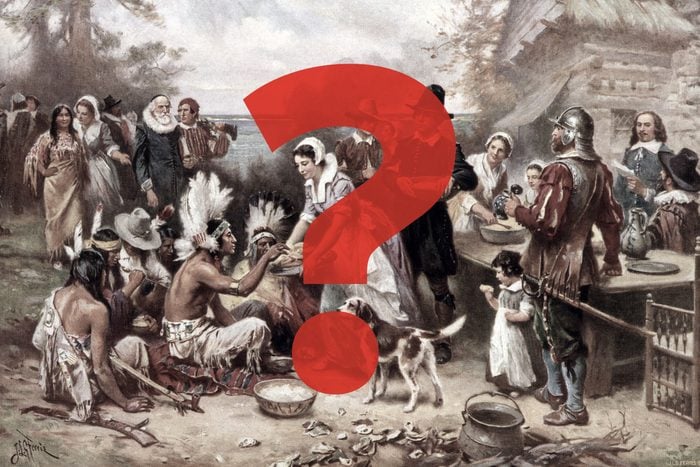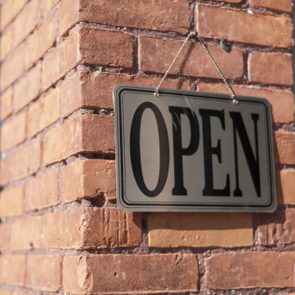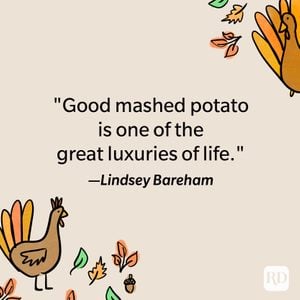The Real History of Thanksgiving
Updated: Feb. 06, 2023

The history of Thanksgiving isn't the rosy story from your childhood. Here's what really happened and the truth about some commonly held Thanksgiving myths.
Americans ranked Thanksgiving as their second-favorite holiday after Christmas. It seems like no surprise—from football games to stuffing to the Macy’s parade, Thanksgiving is both uniquely American and full of treasured traditions. But this rosy picture of modern celebrations leaves out most of the real history of Thanksgiving.
Yes, Thanksgiving is a time to celebrate all the things we are grateful for and get together with loved ones for an epic feast. It’s the start of the holiday season in the United States, providing the foundation for many happy memories and lots of fun. You only have to look at these Thanksgiving quotes and Thanksgiving traditions to see how beloved the holiday is.
But before you even Google “When is Thanksgiving?” spend a little time learning the true roots of the holiday. Doing so will give you a deeper understanding of and appreciation for Thanksgiving, the traditions surrounding it and the people who sacrificed so much. Yes, you can still settle down with family to give thanks. But it’s important to know what you’re celebrating and unlearn some long-held myths.
Did you learn the real history of Thanksgiving?
Chances are your grade-school understanding of the Thanksgiving story involved Pilgrims and Indians sitting down to a happy meal together and becoming fast friends. The lesson likely involved cartoons depicting settlers and Native Americans smiling in celebration, a possible mention of Pocahontas and Thanksgiving crafts.
So what’s wrong with that? Nearly everything, it turns out. For starters, Pocahontas, a member of the Powhatan tribe, died in 1617, four years before the first Thanksgiving. And according to the real history of Thanksgiving, settlers were hardly the kindly, giving Pilgrims we learned about in our youth.
How did Thanksgiving start?
Most of what we know about early American settlers comes from the journal of William Bradford, the first governor of Plymouth, Massachusetts. He notes that in 1620, the Mayflower brought the Pilgrims to Plymouth Rock, where they established a colony and began farming. The following year, they had a bountiful harvest and decided to give thanks for the food with a three-day celebration. Historical records show that there was indeed a meeting between the Pilgrims of Plymouth Colony and the Wampanoag tribe at this time.
But the Native Americans weren’t honored guests. They likely weren’t even invited.
Many historians now think that Wampanoag soldiers heard celebratory gunshots and screams from Pilgrim settlements. The Wampanoag assumed they were under attack, and because they had a diplomatic treaty of mutual defense with the Pilgrims, they sent 90 soldiers to the settlers’ aid, explains Amy Jakober, senior communications officer for the First Nations Development Institute, a nonprofit dedicated to strengthening Native American communities and economies.
When was the first Thanksgiving?
The Pilgrims may have celebrated in 1620, but that wasn’t actually Thanksgiving. So when was the first Thanksgiving? That occurred in the fall of 1621, in what is now Massachusetts. But here’s a piece of Thanksgiving trivia: It didn’t become well known until Bradford’s journal was discovered and published by Sarah Josepha Hale, a magazine editor, in the early 1800s.
Hale was so taken with the story of that first Thanksgiving that she lobbied five U.S. presidents to make it a federal holiday. In 1863, President Abraham Lincoln finally declared Thanksgiving an official U.S. holiday, an act he saw as a step toward reuniting the fractured country after the Civil War. He put it on the calendar for the last Thursday of November.
In December 1941, President Franklin D. Roosevelt changed Thanksgiving to the fourth Thursday in November to avoid confusion in years where there is a fifth Thursday in November. He also reasoned that this change slightly lengthened the holiday season, which was good for the economy. Considering Black Friday is nearly a holiday in and of itself, it’s safe to say he was right.
What did the first Thanksgiving look like?
The first Thanksgiving bore little resemblance to what we would recognize as a traditional Thanksgiving today, some four centuries later.
The event was a harvest festival with a mix of religious, pagan and practical traditions dating back centuries. The pious Pilgrims centered the celebration around Thanksgiving prayers and gratitude to God for their bounty, but they also had bonfires, Thanksgiving songs, food and gunshots that got the attention of the Native Americans.
Contrary to what you might’ve learned in elementary school, this was no potluck dinner where Pilgrims hung elaborate Thanksgiving decorations and Native Americans brought the roasted turkey. But there was a meeting, and they did share a meal together, according to Bradford. The Wampanoag people brought deer, and there was some type of cooked fowl, although it was most likely duck, not turkey. They also ate cranberries, vegetables, cornmeal and pumpkin—but not in the form of pumpkin pie.
Why is the Thanksgiving story controversial?
What’s the harm in believing the happy version so many of us grew up with? It’s just a story, right? This whitewashing downplays the long and bloody series of conflicts between white settlers and Native Americans that would occur over the next two centuries.
“Narratives of a harmonious Thanksgiving celebration were created to justify westward expansion and Manifest Destiny,” Jakober explains. The term “Manifest Destiny,” coined more than two centuries after the first Thanksgiving, was the belief that settlers were destined by God to expand across America and prosper.
The “simple” story also perpetuates myths that still harm Native Americans today, says Raymond Foxworth, PhD, a citizen of the Navajo Nation, member of the board of directors for the Native Arts and Cultures Foundation and vice president of grantmaking, development and communications for the First Nations Development Institute.
What is the real history of Thanksgiving?
“The myths of Thanksgiving marginalize the truth of what really happened in North America. We need to understand, acknowledge and share that true history,” Foxworth says. “Only by doing so can we start to move toward healing and reconciliation between Native people and European colonizers.”
A good place to start: Get the facts about three debunked myths that Foxworth wishes people would understand.
Myths about Thanksgiving history you need to stop believing
Myth: The “first Thanksgiving” started the tradition that founded the holiday
Truth: The harvest celebration of 1621 was not called Thanksgiving and was not repeated every year. The next official “day of thanksgiving” was after settlers massacred more than 400 Pequot men, women and children. Governor Bradford’s journal decreed, “For the next 100 years, every Thanksgiving Day ordained by a governor is in honor of the bloody victory, thanking God that the battle had been won.” We should add that to our list of favorite Thanksgiving quotes as a stark reminder of the real history of Thanksgiving.
Myth: Pilgrims and Native Americans were friends who worked together
Truth: This was true in some limited conditions, like the diplomatic treaty of protection. But more often, the settlers took what they wanted while tens of thousands of Native Americans died of diseases brought by the colonizers (sometimes intentionally), and more were captured and sold into slavery. Even Squanto, famous for translating and teaching the settlers how to farm native crops, learned those skills out of necessity after being kidnapped as a child and sold into slavery in Spain. He returned to Cape Cod to find that he was the only surviving member of his tribe.
Myth: The Pilgrims taught the “uncivilized” Indians about Thanksgiving
Truth: Many people still have a picture of Native Americans living in dirt and squalor until the European settlers enlightened them. Nothing could be further from the truth. Native Americans had large and complex societies long before settlers arrived. They already had established harvest celebrations, feast traditions and holidays of their own. They were also well aware of the virtue of gratitude and had their own religious beliefs and rituals.
How can you help?
Once you understand the complicated real history of Thanksgiving, there are things you can do to celebrate the holiday in a meaningful way while respecting and honoring Native Americans, Foxworth says. You can also make new traditions with your loved ones.
Share the truth
Talk to your children and other loved ones about the real history of Thanksgiving. Correct myths when you hear them. Have open discussions in public places, like schools. You can also share this video made by Native Americans about reclaiming Native truth.
Avoid stereotypes in decorations and crafts
Be aware of how you represent Native Americans in crafts, media and Thanksgiving table settings. For example, in some schools, students may make Thanksgiving crafts like headbands using feathers. “But in many Native American cultures, feathers are highly religious articles, and presenting sacred activities in trivial ways can be highly offensive and disrespectful, even if it seems perfectly innocent,” Foxworth explains.
Donate to organizations led and controlled by Native Americans
Donating money can go a long way toward helping, but not all charities are created equal. The First Nations Development Institute has compiled a list of hundreds of community partners that are working in Native American food sovereignty, language preservation, youth programs, community building and asset building.
Learn more
Read books, both for yourself and with your children, that portray Native American and American history in an accurate way. Seek out books by Native authors. Talk to Native Americans and learn about their culture and how they celebrate Thanksgiving. Choose a book to share with your family on Thanksgiving.
Sources:
- Amy Jakober, senior communications officer for First Nations Development Institute
- Raymond Foxworth, PhD, a citizen of the Navajo Nation, a member of the board of directors for the Native Arts and Cultures Foundation, and vice president of grantmaking, development and communications for the First Nations Development Institute
- The Harris Poll: “Americans Weigh In on Their Favorite Holiday, Most Anticipated Eats, and How They Wash it All Down”
- History of Massachusetts: “Of Plymouth Plantation by William Bradford”



